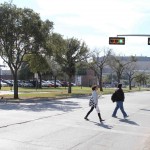

Houston’s streets remain dangerous extremely dangerous, and it’s time for change. | Photo courtesy of LINK Houston
Nicholas Lazarus had come to the board’s Budget Public Meeting on Sept. 19, because of the near- death experience his wife had been through. She had been hit by a train while riding her bike near HCC, and when Lazarus called the Metro’s helpline, they ended the call.
As I watched him lead his limping wife out of public meeting, I realized why instances like this weren’t shocking to me anymore: Houston is expected to be dangerous. In both transit equity and street safety, our city needs change. For the country’s fourth largest city, we are too primitive in our policies and infrastructure.
In Seattle, approximately 6,000 pedestrians and cyclists are involved in crashes every seven years. In Phoenix, approximately 11,500 pedestrians and cyclists are involved in crashes every four years.
In Houston, 12,707 pedestrians or cyclists have been impacted by a crash. This is unacceptable.
LINK Houston, a non-profit that advocates for street safety and transit equity, is working with the city to improve conditions.
LINK Houston has identified ten of the most dangerous intersections in Houston in order to narrow down specific areas for improvement. Ines Sigel, LINK Houston’s director of communications and outreach, has already seen positive feedback to their research.
“We have asked the city to form a multi-disciplinary task force, so that we can investigate what exactly is occurring at these hot spots,” Sigel said. “Recently, The City of Houston agreed to conduct a Road Safety Audit on six of the ten intersections LINK had proposed. We went out with the city investigators and the Federal Highway Association, along with local stakeholders.”
At each intersection, the group tried to understand the needs of the area, looking at factors such as design standards, efficiency of law enforcement, and positioning of road signs.
The audit will be reviewed by the Public Works Department, and necessary changes will be made. If the changes made are beneficial, there is potential for wide-scale systemic changes to be implemented throughout the city.
But successes like these can often be an uphill battle. While advancements in street safety are slowly breaking through red tape, the lack of transit equity still remains a prevalent problem in Houston.
“Transit Equity” refers to the fairness with which transit is distributed in a city. Under-resourced communities are sometimes less dense compared to other areas in the city, so there are less extensive and frequent transit options for them. In these areas, transportation expenses swallow the incomes of residents, off-setting the financial benefits of affordable housing.
Where transit is needed most, it fails to be comprehensively beneficial.
“Transportation should be a shared benefit among all communities,” said Sigel. “But in Houston, areas like Northeast Houston and East Houston could use a lot more transit services because they are the most under-resourced. Those neighborhoods suffered a lot during Harvey, so many residents are without cars. They are already under serviced in transit, and now they need it more than ever.
Interestingly, Gulfton, in Southwest Houston, is one of the most densely populated of Houston. But still, they are lacking efficient transit. The “density” aspect of transportation is supposed to work, but this area is still missed.”
According to a study done by TransitCenter in 2016, “vast majority-minority areas on the southeastern side of the city have no access to frequent bus rail or lines.”
Clearly, there is much to be improved in Houston. Out of the 73 cities with populations greater than 250,000, Houston is ranked No. 34 on the AllTransit Performance score. This measures how well a city performs in transit connectivity. For the fourth largest city in the nation, with a booming economy and flourishing population, we should be performing much better.
Transit equity and street safety are important factors that affect everyone, and their significance should be recognized. The city needs to improve structural design, and increase enforcement of laws regarding the safety of pedestrians and cyclists.
We should concentrate our transit resources into areas that are in need of them, so that our city can be a more fair, safe, and productive place to live and work.
Opinion editor Wafa Kazmi is a communication sciences and disorders junior, and can be reached at opinion@thedailycougar.com
—
“Houston needs better streets and better transit” was originally posted on The Daily Cougar
